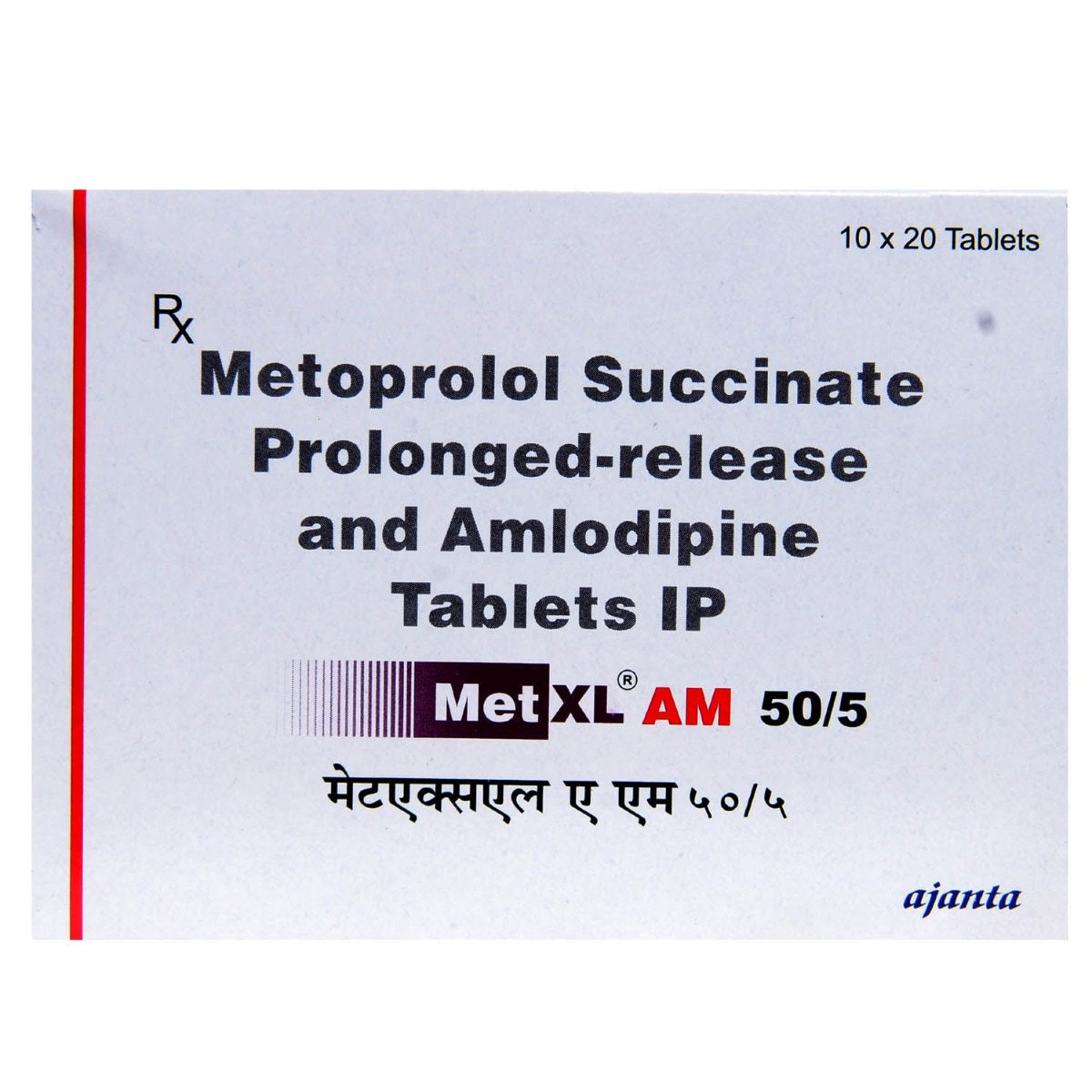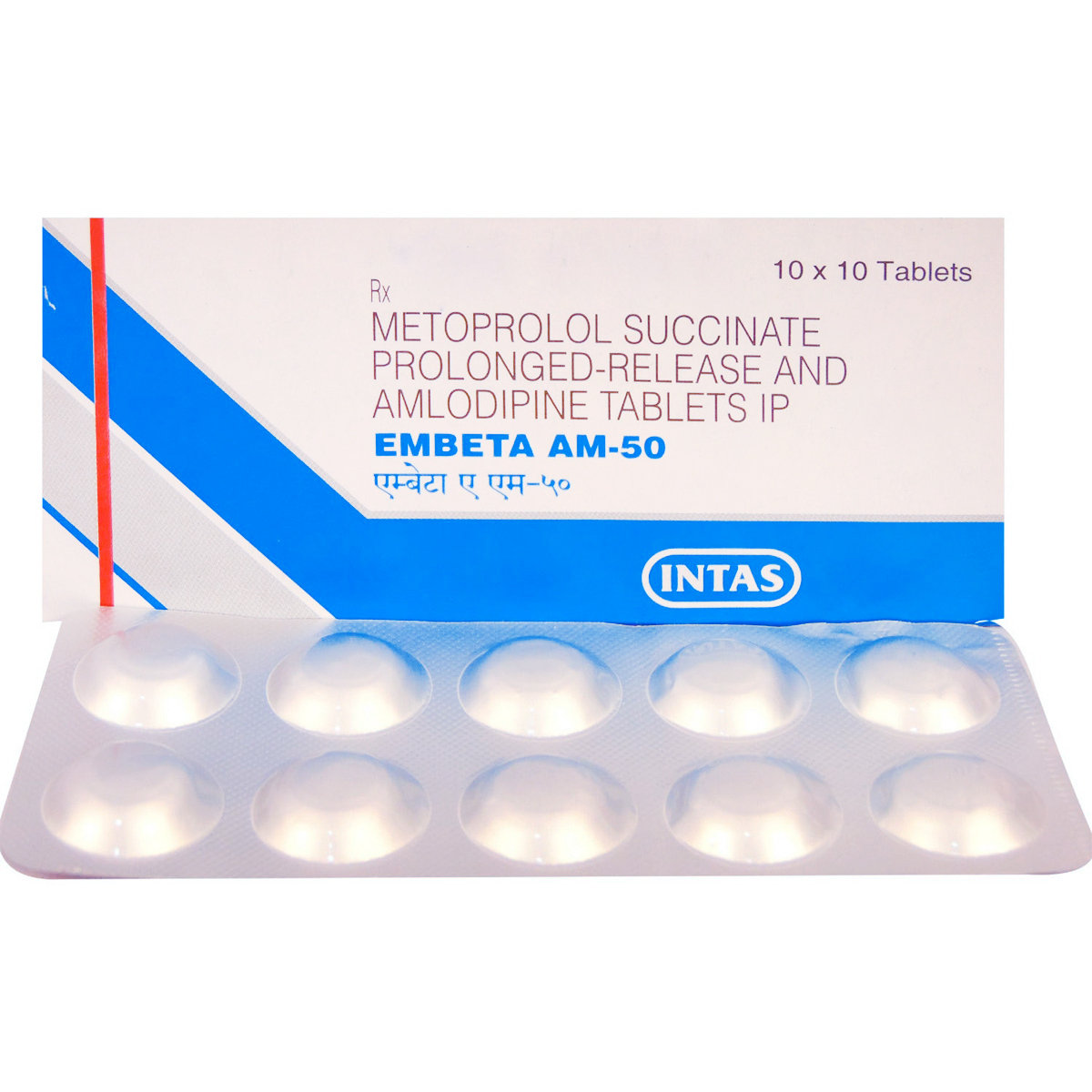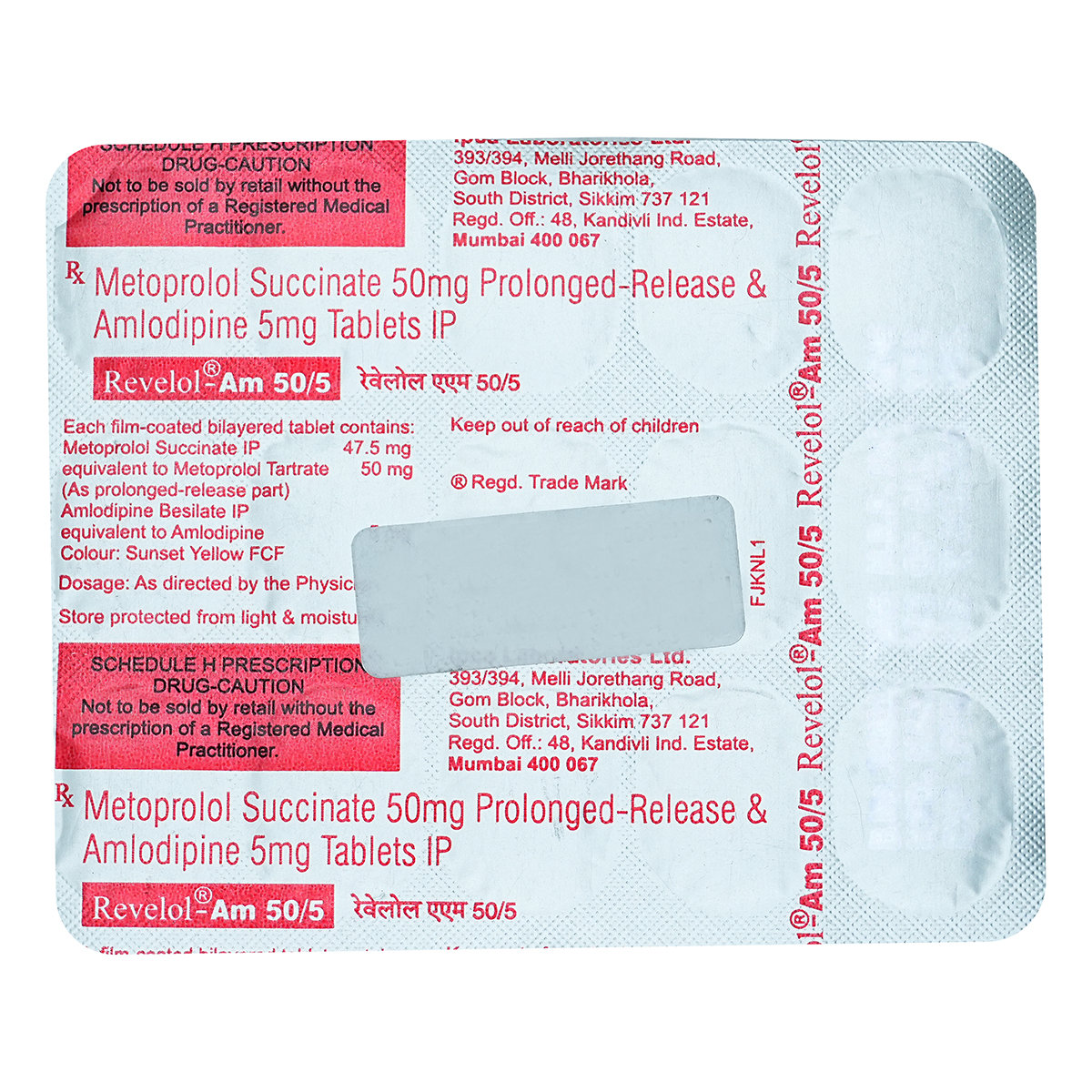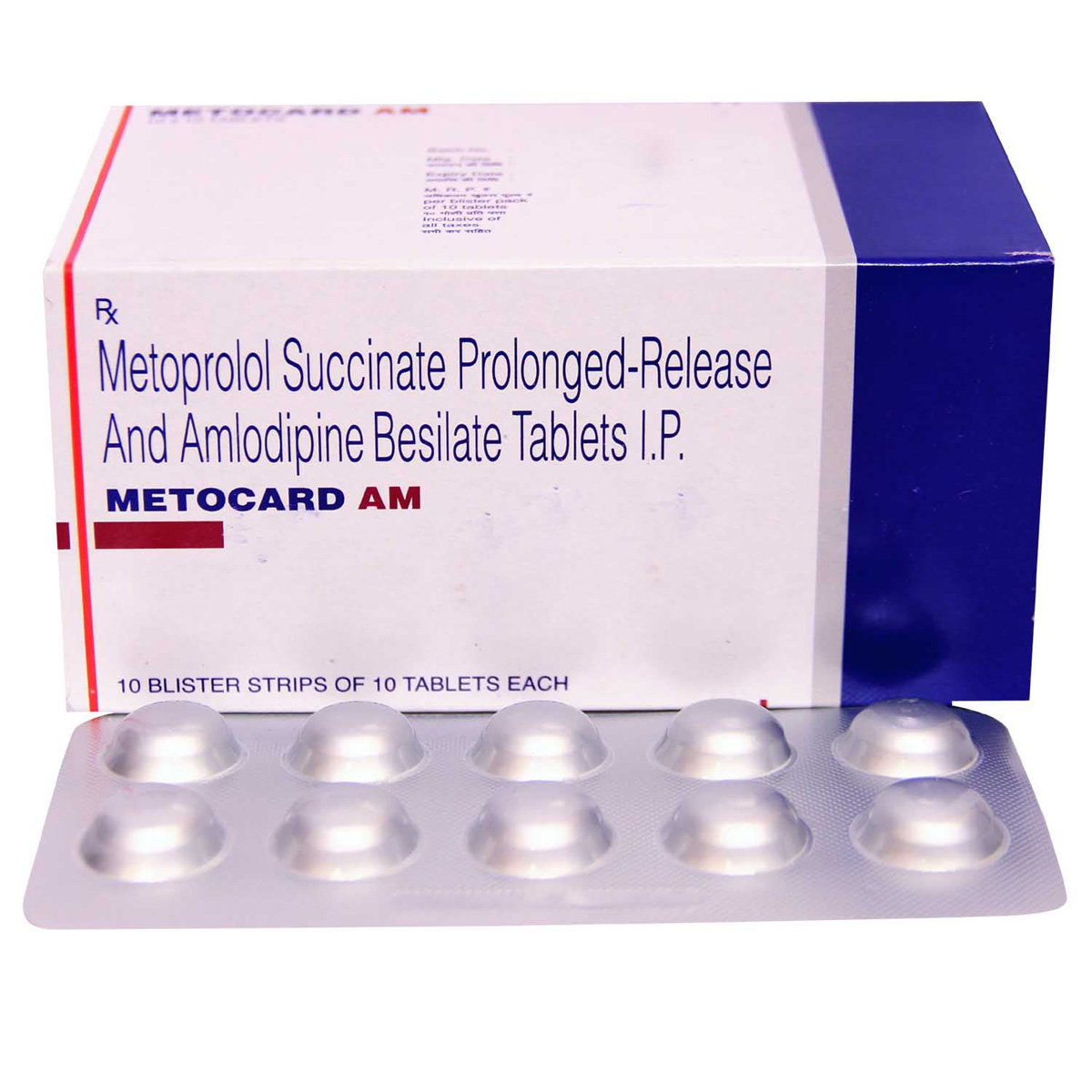Prolomet AM 50 Tablet 10's




MRP ₹150.5
(Inclusive of all Taxes)
₹22.6 Cashback (15%)
Provide Delivery Location
Online payment accepted
 Prescription drug
Prescription drugWhats That
Composition :
Manufacturer/Marketer :
Consume Type :
Expires on or after :
Return Policy :
About Prolomet AM 50 Tablet
Prolomet AM 50 Tablet belongs to the class of drugs known as antihypertensive, used to treat hypertension (increased blood pressure). Hypertension (high blood pressure) is a lifelong or chronic condition in which the force exerted by the blood against the artery walls becomes so high that it leads to heart disease. If it continues for a long time, the heart and arteries may not function properly. This can damage the blood vessels of the brain, heart, and kidneys, resulting in a stroke, heart failure, or kidney failure. Lowering blood pressure may reduce the risk of stroke and heart attacks.
Prolomet AM 50 Tablet is a fixed-dose combination composed of two medicines, namely: Amlodipine and Metoprolol. Amlodipine is a calcium channel blocker while Metoprolol belongs to a group of medicines called beta-blockers. Metoprolol relaxes blood vessels by blocking the action of certain natural substances in your body. On the other hand, Amlodipine widens and relaxes the blood vessels making the heart more efficient at pumping blood throughout the body. Together, it helps to lower high blood pressure, reducing the chances of heart attack or stroke. Prolomet AM 50 Tablet is prescribed to adults and children more than six years of age.
Prolomet AM 50 Tablet can be taken with or without food as directed by your physician. Swallow the whole tablet with a glass of water. Do not crush, chew, or break it. Prolomet AM 50 Tablet is preferable to take at the same time every day for better results. Prolomet AM 50 Tablet is generally safe to consume. Some people may experience nausea, vomiting, diarrhoea, fatigue, headache, low heart rate, and breathlessness. Most of the side effects of Prolomet AM 50 Tablet do not require medical attention and gradually resolve over time. However, if the side effects are persistent, reach out to your doctor.
Don't stop taking $ name without talking to your doctor first. Stopping Prolomet AM 50 Tablet gradually may cause changes in your heart rhythm and blood pressure, cause chest pain, or a heart attack. Your doctor will lower your dose gradually over some time to help prevent these symptoms. It is advisable to drink plenty of fluids while taking this medicine to overcome muscle weakness, dry mouth, and extreme thirst. Do not take grapefruit or grapefruit juices with Prolomet AM 50 Tablet as it can increase the concentration of Prolomet AM 50 Tablet and worsen its side effects.
Uses of Prolomet AM 50 Tablet
Directions for Use
Key Benefits
Prolomet AM 50 Tablet is used to treat heart-related conditions like angina (chest pain) and high blood pressure. Amlodipine is a calcium channel blocker that inhibits the entry of calcium (ions) across the heart that relaxes and widens the heart smooth muscles for better blood flow. Metoprolol plays a vital role in relaxing our blood vessels and lowering blood pressure by blocking the action of certain natural substances in your body. Besides this, Prolomet AM 50 Tablet help prevent spasm of the coronary artery and reduces how hard the heart has to work to pump blood around the body, lowering its oxygen requirements. It improves an individual’s tolerance to physical activity and exercise to keep their blood pressure normal during exercise. As a result, heart rate is at maximum, and exercise does not affect the blood pressure in anyways.
Storage
- Rest well; get enough sleep.
- Eat a balanced diet and drink enough water.
- Manage stress with yoga and meditation.
- Limit alcohol and caffeine.
- Physical activities like walking or jogging might help boost energy and make you feel less tired.
- Tell your doctor immediately if you experience shortness of breath after taking medication.
- Your doctor may adjust the medication regimen or dosage or give alternative medical procedures to minimize the symptoms of shortness of breath.
- Monitor your oxygen levels and breathing rate regularly to track changes and potential side effects.
- For controlling stress and anxiety, try relaxation techniques like deep breathing exercises, meditation, or yoga.
- Make lifestyle changes, such as quitting smoking, exercising regularly, and maintaining a healthy weight.
- Seek emergency medical attention if you experience severe shortness of breath, chest pain, or difficulty speaking.
- Follow up regularly with your doctor to monitor progress, adjust treatment plans, and address any concerns or questions.
- Skin rash caused by allergies is due to irritants or allergens. Therefore, avoid contact with such irritants.
- Consult your doctor for proper medication and apply an anti-itch medication. Follow the schedule and use the medication whenever needed.
- Protect your skin from extreme heat and try to apply wet compresses.
- Soak in the cool bath, which gives a soothing impact to the affected area.
- Hydrate your body: Drink enough water to prevent dehydration and headaches.
- Calm Your Mind: Deep breathing and meditation can help you relax and relieve stress.
- Rest and Recharge: Sleep for 7-8 hours to reduce headache triggers.
- Take rest: lie down in a quiet, dark environment.
- Cold or warm compresses can help reduce tension.
- Stay Upright: Maintain good posture to keep symptoms from getting worse.
- To treat headaches naturally, try acupuncture or massage therapy.
- Over-the-counter pain relievers include acetaminophen and ibuprofen.
- Prescription Assistance: Speak with your doctor about more substantial drug alternatives.
- Severe Headaches: Seek emergency medical assistance for sudden, severe headaches.
- Frequent Headaches: If you get reoccurring headaches, consult your doctor.
- Headaches with Symptoms: Seek medical attention if your headaches include fever, disorientation, or weakness.
- Reduce salt intake to minimize fluid buildup.
- Use compression stockings, sleeves, or gloves.
- Gently massage the affected area towards the heart.
- Protect the swollen area from injury and keep it clean.
- Use lotion or cream to keep the skin moisturized.
- Inform your doctor about dizziness symptoms. They may adjust your medication regimen or prescribe additional medications to manage symptoms.
- Follow your doctor's instructions for taking medication, and take it at the same time every day to minimize dizziness.
- When standing up, do so slowly and carefully to avoid sudden dizziness.
- Avoid making sudden movements, such as turning or bending quickly, which can exacerbate dizziness.
- Drink plenty of water throughout the day to stay hydrated and help alleviate dizziness symptoms.
- If you're feeling dizzy, sit or lie down and rest until the dizziness passes.
- Track when dizziness occurs and any factors that may trigger it, and share this information with your doctor to help manage symptoms.
- Consult your doctor if you experience skin redness, itching, or irritation after taking medication.
- Your doctor may adjust your treatment plan by changing your medication or providing guidance on managing your erythema symptoms.
- Your doctor may recommend or prescribe certain medications to help alleviate symptoms.
- Apply cool compresses or calamine lotion to the affected skin area to reduce redness and itching.
- Stay hydrated by drinking plenty of water to help alleviate symptoms and keep your skin hydrated.
- Monitor your skin condition closely and promptly report any changes, worsening symptoms, or concerns to your healthcare provider.
Drug Warnings
Don't stop taking the medication without talking to your doctor first. Stopping Prolomet AM 50 Tablet gradually may cause changes in your heart rhythm and blood pressure, cause chest pain, or a heart attack. Your doctor will lower your dose gradually over a period of time to help prevent these symptoms. Prolomet AM 50 Tablet can cause low blood sugar (hypoglycaemia). This medication should be used with caution if you have diabetes, particularly if you are taking insulin or other diabetes drugs that may cause low blood sugar. This medication can also induce low blood sugar in babies, children and adults who do not have diabetes. Do not take Prolomet AM 50 Tablet if you have asthma or similar breathing difficulties. It could make your asthma severe.
Drug-Drug Interactions
Drug-Drug Interactions
Login/Sign Up
Using Prolomet AM 50 Tablet together with dantrolene may increase the risk of hyperkalemia (high blood potassium).
How to manage the interaction:
Taking Prolomet AM 50 Tablet with Dantrolene can cause an interaction, consult a doctor before taking it. You should seek medical attention if you experience nausea, vomiting, weakness, confusion, tingling of the hands and feet, a weak pulse, or a slow or irregular heartbeat. Do not stop using any medications without talking to a doctor.
Taking ceritinib together with Prolomet AM 50 Tablet can slow your heart rate and increase the risk of an irregular heart rhythm.
How to manage the interaction:
Although there is a interaction between Prolomet AM 50 Tablet and Ceritinib, but they can be taken together if your doctor has prescribed them. However, consult your doctor immediately if you experience any dizziness, lightheadedness, fainting, or irregular heartbeat. Do not discontinue any medications without consulting a doctor.
Coadministration of Prolomet AM 50 Tablet with Verapamil may lead to increased side effects.
How to manage the interaction:
Although there may be an interaction, Prolomet AM 50 Tablet can be taken with Verapamil if prescribed by the doctor. Consult a prescriber if you experience fatigue, headache, fainting, swelling of the extremities, weight gain, shortness of breath, chest pain, increased or decreased heartbeat, or irregular heartbeat. Do not discontinue any medications without a doctor's advice.
Coadministration of Aminophylline with Prolomet AM 50 Tablet together can make Prolomet AM 50 Tablet less effective and increase the effects of aminophylline.
How to manage the interaction:
Taking Aminophylline with Prolomet AM 50 Tablet may lead to an interaction, it can be taken only if a doctor has advised it. If you experience nausea, vomiting, sleeplessness, restlessness, irregular heartbeats, or difficulty in breathing, contact a doctor immediately. Do not discontinue any medications without consulting a doctor.
Coadministration of Acebutolol with Prolomet AM 50 Tablet can cause abnormal heart rhythm.
How to manage the interaction:
Taking Prolomet AM 50 Tablet and Acebutolol together can possibly result in an interaction, it can be taken if your doctor has advised it. However, if you experience blurry vision, confusion, dizziness, fainting, lightheadedness, nausea or vomiting, contact your doctor immediately. Do not discontinue any medications without consulting a doctor.
Co-administration of Clonidine and Prolomet AM 50 Tablet may lower blood pressure and slow the heart rate.
How to manage the interaction:
Although there is a possible interaction between Clonidine and Prolomet AM 50 Tablet, you can take these medicines together if prescribed by your doctor. However, if you experience headaches, slow heartbeat, dizziness, or feeling like you might pass out, contact your doctor. Do not stop using any medications without first talking to your doctor.
Coadministration of Prolomet AM 50 Tablet and Tizanidine may reduce the efficiency of Prolomet AM 50 Tablet.
How to manage the interaction:
Taking Prolomet AM 50 Tablet and Tizanidine together can possibly result in an interaction, it can be taken if your doctor has advised it. However, if you experience blurry vision, confusion, dizziness, fainting, lightheadedness, nausea or vomiting, contact your doctor immediately. do not discontinue any medications without talking to your doctor.
Using Prolomet AM 50 Tablet and Saquinavir can increase the risk of an irregular heart rhythm.
How to manage the interaction:
There may be a possible interaction between Prolomet AM 50 Tablet and Saquinavir, but they can be taken together if your doctor has prescribed them. However, consult a doctor immediately if you experience dizziness, lightheadedness, fainting, slow pulse, or irregular heartbeat. Do not discontinue any medications without consulting a doctor.
Both Prolomet AM 50 Tablet and Artemether may increase the blood levels and effects of Prolomet AM 50 Tablet activity.
How to manage the interaction:
Taking Prolomet AM 50 Tablet and Artemether together can possibly result in an interaction, it can be taken if your doctor has advised it. However, if you experience blurry vision, confusion, dizziness, fainting, lightheadedness, nausea or vomiting, contact a doctor immediately. Do not discontinue any medications without consulting a doctor.
Use of Prolomet AM 50 Tablet with Atazanavir may increase the risk of an irregular heart rhythm.
How to manage the interaction:
Although there may be an interaction between Prolomet AM 50 Tablet and Atazanavir, it can be taken if prescribed by the doctor. Consult the doctor if you experience dizziness, lightheadedness, fainting, or irregular heartbeat, contact your doctor immediately. Do not discontinue any medications without consulting a doctor.
Drug-Food Interactions
Drug-Food Interactions
Login/Sign Up
Grapefruit Juice, Grapefruit
How to manage the interaction:
Taking Amlodipine and Metoprolol with grapefruit and grapefruit juice significantly increases the metabolism of Amlodipine and Metoprolol. Avoid taking Amlodipine and Metoprolol with grapefruit and grapefruit juice.
Diet & Lifestyle Advise
- Keep your weight under control with BMI 19.5-24.9.
- Do regular physical activity or exercise for at least 150 minutes per week, or about 30 minutes most days of the week. Doing this can help you to lower your raised blood pressure by about 5 mm of Hg.
- Limit intake of sodium chloride (table salt) in your daily diet to 2300 mg per day or less than 1500 mg is ideal for most adults.
- If you are taking alcohol then only one serving for women and two servings for men is advisable.
- Quitting smoking is the best strategy to lower the risk of heart disease.
- Avoid chronic stress as it can raise your blood pressure. Try to enjoy and spent time with your loved ones to cope with stress and practice mindfulness techniques.
- Monitor your blood pressure daily and if there is too much fluctuation then immediately contact your doctor.
- Try to include heart-healthy omega 3 fatty acid containing food drinks in your daily diet. You can also use low-fat cooking oil like olive oil, soybean oil, canola oil, and coconut oil can help in lowering your elevated blood pressure.
Side Effects of Prolomet AM 50 Tablet
- Oedema (swelling)
- Dizziness
- Flushing
- Palpitation
- Vertigo
- Bradycardia (slow heart rate)
- Headache
- Feeling exhausted
- Swollen ankles
- Flushing
- Stomach upset
- Increased levels of potassium in the blood
- Dry mouth
- Change in taste
- Blurred vision
- Difficulty in breathing
- Cold fingers or toes
Habit Forming
Therapeutic Class
All Substitutes & Brand Comparisons
RX
Gudpres AM 50 Tablet 10's
Mankind Pharma Pvt Ltd
₹97
(₹8.74 per unit)
35% CHEAPERRX
Amlokind Beta 50 Tablet 10's
Mankind Pharma Pvt Ltd
₹106.5
(₹9.59 per unit)
29% CHEAPERRX
Protol-AM Tablet 10's
Eris Life Sciences Ltd
₹120
(₹10.8 per unit)
20% CHEAPER
Product Substitutes
Drug-Diseases Interactions
Drug-Diseases Interactions
Login/Sign Up
FAQs
No, you are advised to inform your doctor and monitor your blood pressure for at least two weeks before stopping the medicine. Depending upon your current blood pressure readings, there is a possibility your doctor may lower your medicine dosage and not recommend to discontinue it.
In case, you have missed a dose of Prolomet AM 50 Tablet , you are advised to take it as soon as you remember. However, try not to miss a dose in the first place, if it's time for you to take your next dose, then do not take both doses together. Take only one dose, taking a double dose of Prolomet AM 50 Tablet will lead to low blood pressure.
When you are taking a beta-blocker, your health care provider may recommend that you limit your consumption of bananas and other high potassium foods including papaya, tomato, avocado and kale.
Prolomet AM 50 Tablet can be safely taken as long as your doctor has prescribed it to you. Conditions such as high blood pressure are life-long conditions and one should not abruptly discontinue it without discussing it with a doctor.
Yes, Prolomet AM 50 Tablet is contraindicated in people with known allergy to any of the components of this medicine. It should be avoided in people with severe kidney or liver impairment and in people with anuria (reduction or absence of urine). It should also be avoided in women who are in the second and third trimesters of their pregnancy.
It's unlikely that Prolomet AM 50 Tablet affects fertility in men or women. However, there's not enough evidence to say for certain. For the best advice, consult your doctor.
Yes, Prolomet AM 50 Tablet is known to cause ankle swelling. Please try to keep your feet up when sitting for long hours. If the problem persists still, consult your doctor and do as advised.
Yes, Prolomet AM 50 Tablet can cause dry mouth. Therefore, it is always advised to increase fluid intake while taking Prolomet AM 50 Tablet . If you still feel excessively thirsty, please consult your doctor and do as advised for best results of Prolomet AM 50 Tablet .
Drug-Drug Interactions Checker List
- ATENOLOL
- BISOPROLOL
- METOPROLOL
- NEBIVOLOL
- SOTALOL
- LISINOPRIL
- ENALAPRIL
- DILTIAZEM
- PRAZOSIN
- THEOPHYLLINE
- FLUOXETINE
- PAROXETINE
- DIGOXIN
- KETOCONAZOLE
- ITRACONAZOLE
- RITONAVIR
Disease/Condition Glossary
Blood pressure is the measurement of the force that our heart uses to pump blood to all parts of the body. Hypertension is a chronic condition when blood pressure is too high. This condition can lead to hardened arteries (blood vessels), decreasing the blood and oxygen flow to the heart. Raised blood pressure can cause chest pain (angina) and heart attack (when blood supply to the heart is blocked). Additionally, high blood pressure also causes brain damage (stroke) and kidney failure. High blood pressure can be diagnosed with the help of a blood pressure monitor or sphygmomanometer. Systolic pressure is the pressure when the heart pumps blood out. On the other hand, diastolic pressure is the pressure when your heart is at the resting stage between heartbeats. If your blood pressure is 140/90 mm of Hg, it means the systolic pressure is 140 mm of Hg and, diastolic pressure is 90 mm of Hg. Ideal blood pressure should be between 90/60 mm of Hg and 120/80 mm of Hg.

Have a query?
Buy best Cardiology products by
Torrent Pharmaceuticals Ltd
Sun Pharmaceutical Industries Ltd
Lupin Ltd
Intas Pharmaceuticals Ltd
Cipla Ltd
Micro Labs Ltd
Macleods Pharmaceuticals Ltd
Abbott India Ltd
Ajanta Pharma Ltd
Ipca Laboratories Ltd
Eris Life Sciences Ltd
Mankind Pharma Pvt Ltd
Lloyd Healthcare Pvt Ltd
Dr Reddy's Laboratories Ltd
Glenmark Pharmaceuticals Ltd
Emcure Pharmaceuticals Ltd
Alembic Pharmaceuticals Ltd
Alkem Laboratories Ltd
East West Pharma India Pvt Ltd
USV Pvt Ltd
Zydus Healthcare Ltd
Aristo Pharmaceuticals Pvt Ltd
Elbrit Life Sciences Pvt Ltd
J B Chemicals & Pharmaceuticals Ltd
Zydus Cadila
Akumentis Healthcare Ltd
Alteus Biogenics Pvt Ltd
Hbc Life Sciences Pvt Ltd
Fusion Health Care Pvt Ltd
Troikaa Pharmaceuticals Ltd
La Renon Healthcare Pvt Ltd
Corona Remedies Pvt Ltd
Jubilant Lifesciences Ltd
Medley Pharmaceuticals Ltd
Knoll Healthcare Pvt Ltd
Msn Laboratories Pvt Ltd
Zuventus Healthcare Ltd
Cadila Pharmaceuticals Ltd
Blue Cross Laboratories Pvt Ltd
Lividus Pharmaceuticals Pvt Ltd
Morepen Laboratories Ltd
Ranmarc Labs
Shrrishti Health Care Products Pvt Ltd
Sanofi India Ltd
Steris Healthcare
Elder Pharmaceuticals Ltd
Primus Remedies Pvt Ltd
Unison Pharmaceuticals Pvt Ltd
Eswar Therapeutics Pvt Ltd
Knoll Pharmaceuticals Ltd
Tas Med India Pvt Ltd
Systopic Laboratories Pvt Ltd
Indiabulls Pharmaceuticals Pvt Ltd
Leeford Healthcare Ltd
Sinsan Pharmaceuticals Pvt Ltd
Biochem Pharmaceutical Industries Ltd
Cadila Healthcare Ltd
Azkka Pharmaceuticals Pvt Ltd
Nirvana India Pvt Ltd
Orsim Pharma
Prevego Healthcare & Research Pvt Ltd
Econ Healthcare
Elinor Pharmaceuticals (P) Ltd
FDC Ltd
Sunij Pharma Pvt Ltd
Nicholas Piramal India Ltd
Astra Zeneca Pharma India Ltd
Pfizer Ltd
Lia Life Sciences Pvt Ltd
Shine Pharmaceuticals Ltd
Elicad Pharmaceuticals Pvt Ltd
Indoco Remedies Ltd
Proqol Health Care Pvt Ltd
Vasu Organics Pvt Ltd
Biocon Ltd
Opsis Care Lifesciences Pvt Ltd
Johnlee Pharmaceuticals Pvt Ltd
Merck Ltd
Wockhardt Ltd
Auspharma Pvt Ltd
Ergos Life Sciences Pvt Ltd
Lakshya Life Sciences Pvt Ltd
Ordain Health Care Global Pvt Ltd
Pficus De Med Pvt Ltd
ALICAN PHARMACEUTICAL PVT LTD
RPG Life Sciences Ltd
Glynis Pharmaceuticals Pvt Ltd
Orris Pharmaceuticals
Samarth Life Sciences Pvt Ltd
Aprica Pharmaceuticals Pvt Ltd
Aretaeus Pharmaceuticals Pvt Ltd
Koye Pharmaceuticals Pvt Ltd
Neocardiab Care
Retra Life Science Pvt Ltd
Alniche Life Sciences Pvt Ltd
Alvio Pharmaceuticals Pvt Ltd
Arkas Pharma Pvt Ltd
Atos Lifesciences Pvt Ltd
Divine Savior Pvt Ltd
Metalis Lifesciences Pvt Ltd
Alcohol
Safe if prescribed
You are recommended not to consume alcohol along with Prolomet AM 50 Tablet to avoid unpleasant side-effects.
Pregnancy
Consult your doctor
Prolomet AM 50 Tablet is not recommended during pregnancy unless your doctor considers it essential. Your doctor will weigh the benefits and any potential risks before prescribing it to you.
Breast Feeding
Consult your doctor
Prolomet AM 50 Tablet is not recommended while breastfeeding.
Driving
Safe if prescribed
Prolomet AM 50 Tablet is unlikely to affect your ability to drive or to operate machinery. However, some people may occasionally feel dizzy or tired when taking Propranolol. If this happens to you, ask your doctor for advice.
Liver
Consult your doctor
Prolomet AM 50 Tablet to be taken with caution, especially if you have a history of Liver diseases/conditions. The dose may have to be adjusted by your doctor.
Kidney
Consult your doctor
Prolomet AM 50 Tablet to be taken with caution, especially if you have a history of Kidney diseases/conditions. The dose may have to be adjusted by your doctor.
Children
Safe if prescribed
The safety and efficacy of Prolomet AM 50 Tablet in children have not been established. Prolomet AM 50 Tablet is not recommended in children.
Recommended for a 30-day course: 3 Strips


















